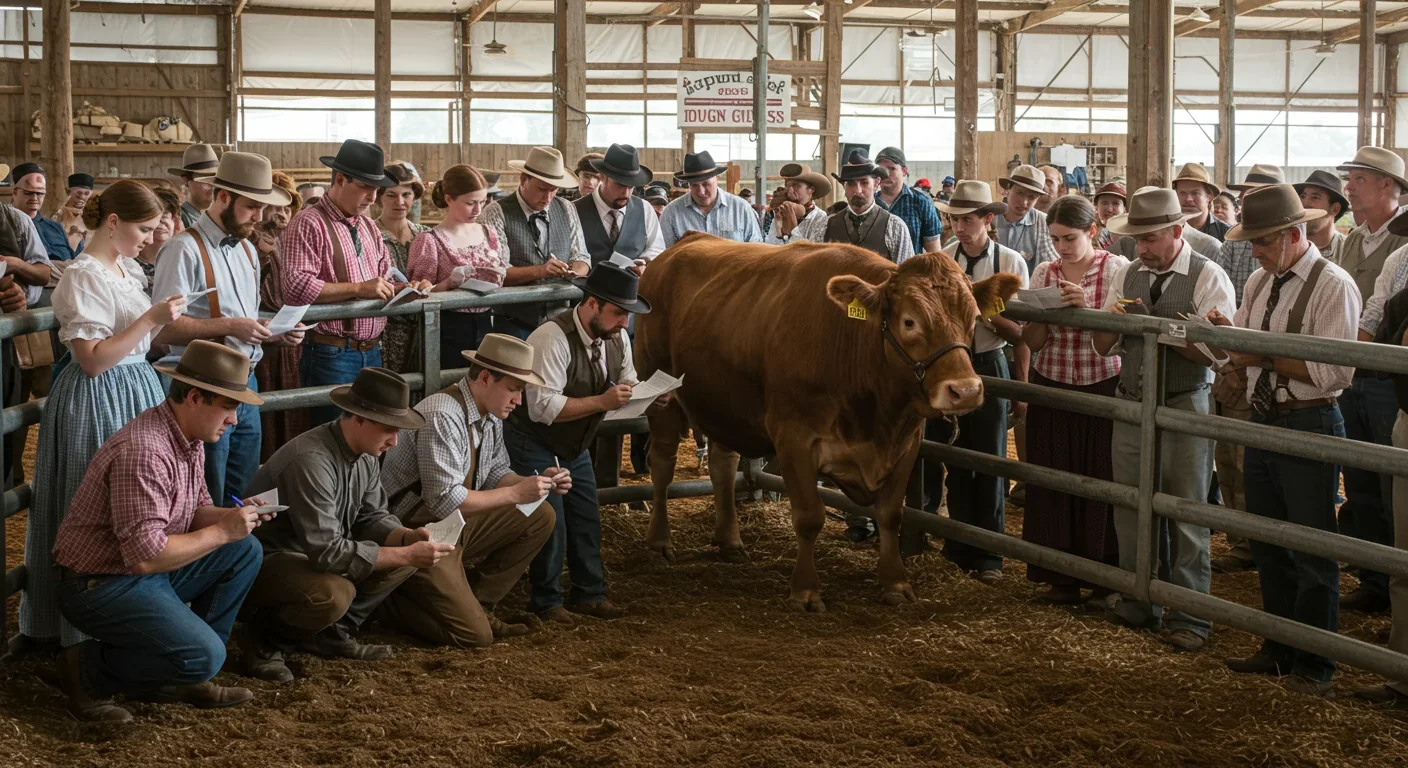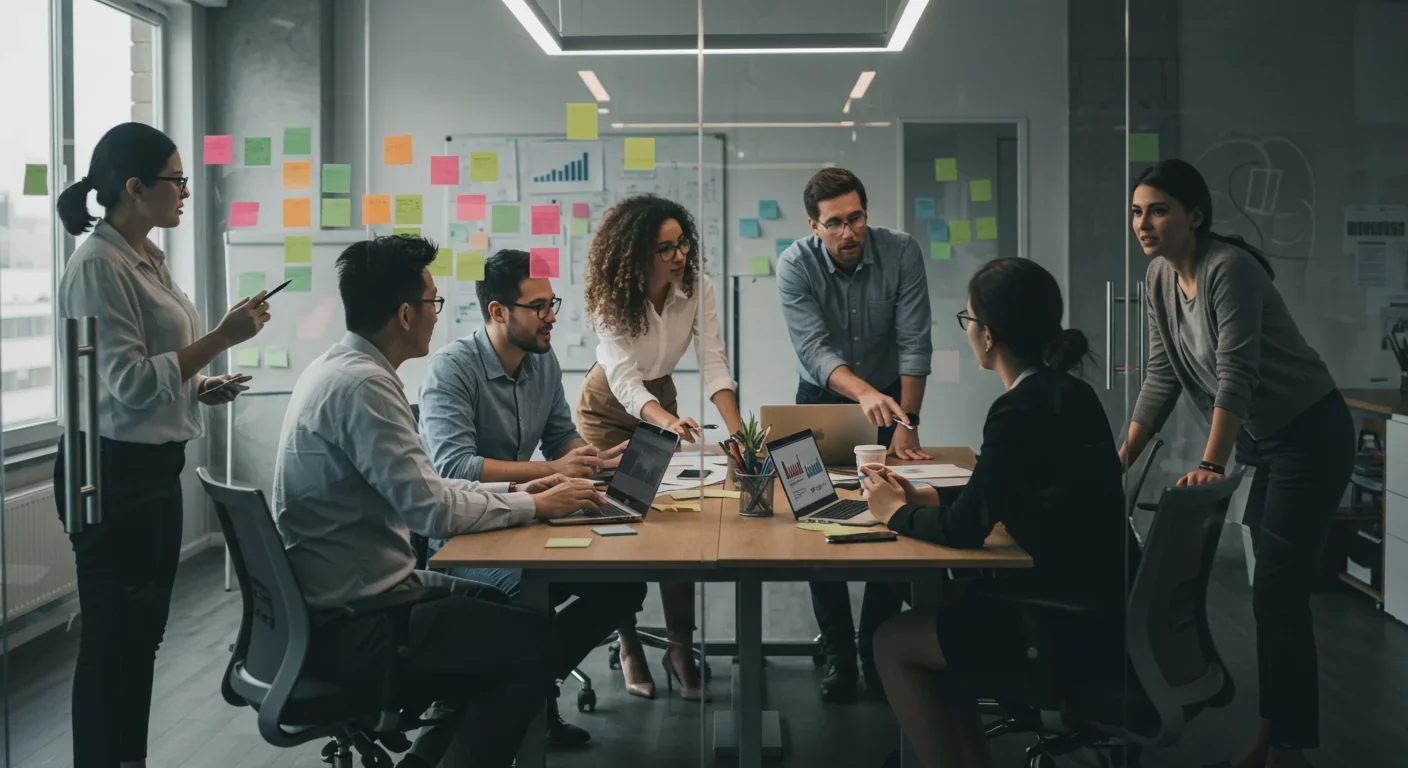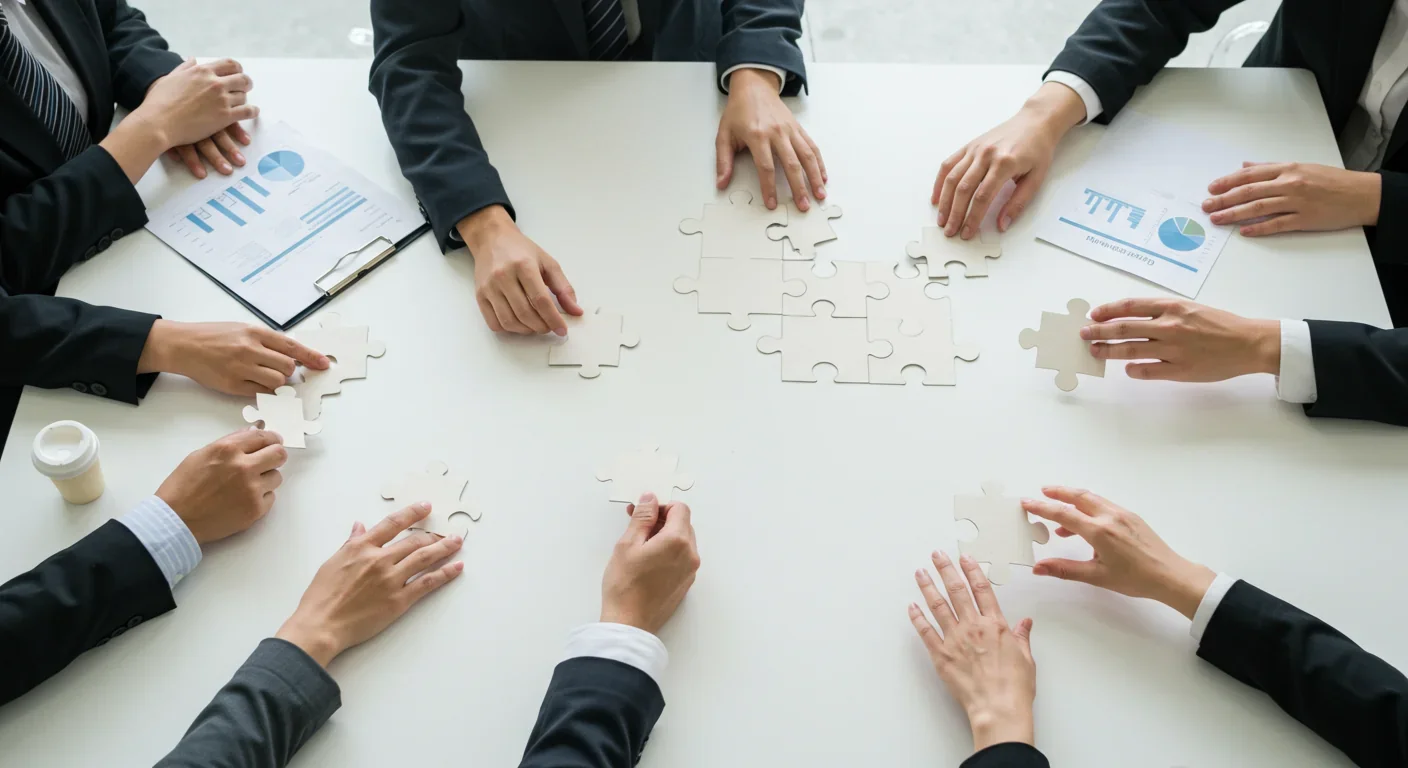Why Your Brain Sees Gods and Ghosts in Random Events

TL;DR: When properly structured with diversity, independence, and good aggregation, crowds consistently outperform individual experts at prediction and estimation. But social media broke these conditions, turning collective intelligence into viral chaos.

In 1906, a curious scientist named Francis Galton attended a county fair where fairgoers competed to guess the weight of an ox. Nearly 800 people submitted estimates, and when Galton calculated the average of all those guesses, something remarkable happened. The crowd's collective guess was 1,197 pounds. The ox's actual weight? 1,198 pounds. They were off by just one pound.
This wasn't luck. It was our first glimpse into a phenomenon that would revolutionize decision-making across industries, from Wall Street trading floors to NASA's asteroid detection systems. Today, while we celebrate individual genius and defer to credentialed experts, the data tells a different story: under the right conditions, large groups of ordinary people consistently outperform even the most qualified specialists.
The science behind collective intelligence isn't mystical or democratic idealism. It's cold, hard statistics. When you aggregate independent judgments from diverse individuals, random errors cancel each other out while the signal emerges stronger.
Think of it like this: imagine 1,000 people estimating the number of jellybeans in a jar. Some will guess too high, others too low. But those high and low errors don't all lean the same direction because each person brings different reference points, estimation strategies, and biases. The mathematical beauty is that errors scatter randomly around the true answer, and when you average them, they neutralize each other.
But here's the catch, and it's huge: this only works under four specific conditions. First, you need diversity of opinion—people drawing on different information and perspectives. Second, independence—individuals must form judgments without being influenced by others. Third, decentralization—people should rely on local, specialized knowledge. Fourth, you need an aggregation mechanism that efficiently combines all those judgments into a collective decision.
Break any of these conditions, and the magic evaporates. Which is exactly what's happened in our hyperconnected digital age, but we'll get to that.
The evidence is overwhelming. Prediction markets have consistently beaten expert forecasts for project completion dates, sales figures, and even geopolitical events. Companies like Google, Ford, and the U.S. Department of Defense use internal prediction markets because they've discovered something counterintuitive: aggregating the hunches of engineers, middle managers, and analysts produces better forecasts than asking senior executives.
At NASA, the story gets even more dramatic. When the agency launched its Asteroid Data Hunter challenge, opening up asteroid detection to the crowd, they didn't just get marginal improvements. Detection accuracy jumped 15%, and false positives dropped compared to NASA's existing expert systems. The crowd wasn't just good—they were better than rocket scientists at detecting space rocks.
Consider Wikipedia, perhaps the most successful collective intelligence project in human history. Traditional encyclopedias relied on credentialed experts painstakingly writing and reviewing articles. Wikipedia threw open the gates to anyone with internet access. Skeptics predicted chaos. Instead, research shows Wikipedia's accuracy rivals Britannica for scientific topics, while covering exponentially more subjects with faster updates.
The pattern repeats across domains. In a recent AI forecasting tournament, a hybrid system combining human superforecasters with AI outperformed traditional expert predictions on complex geopolitical and technological questions. The key wasn't more credentials, but better information aggregation.
Here's the uncomfortable truth: individual human judgment is riddled with systematic biases that expertise doesn't eliminate. Overconfidence, anchoring, availability bias, confirmation bias—these cognitive quirks affect Nobel laureates and novices alike.
Experts are particularly vulnerable to a dangerous trap: they know so much about their domain that they struggle to imagine being wrong. This metacognitive confidence paradox means specialists often make more extreme predictions with more conviction, even when the evidence suggests uncertainty.
Meanwhile, crowds benefit from what researchers call "cognitive diversity." When you assemble people with different backgrounds, they literally think differently about problems. An economist approaches market predictions differently than a sociologist, who thinks differently than a technologist. Those varied mental models produce different errors that cancel out when aggregated.
But individual intelligence still matters. Recent research on dyadic collective intelligence reveals that for well-structured tasks with clear right answers, the cognitive abilities of group members are the strongest predictor of group performance, more than social factors like communication patterns.
The sweet spot is assembling cognitively able individuals who think differently, then keeping them independent so their unique perspectives don't collapse into groupthink.

If crowds are so smart, why does social media feel like a catastrophic failure of collective intelligence?
Because the internet systematically violates every condition required for wisdom of crowds.
Social platforms are designed to eliminate independence. You see what others think before forming your own opinion. Trending topics, like counts, viral threads—they all function as massive conformity engines. Research on herding behavior shows that even subtle social cues (seeing that others have liked a post) dramatically shift people's judgments.
Algorithms destroy diversity by creating filter bubbles. Instead of a crowd representing different information sources, you get thousands of people who've all consumed the same viral content, mistaking consensus in their echo chamber for broader truth.
The decentralization collapses because platforms centralize information flow. A few viral posts reach millions, drowning out local, specialized knowledge. Everyone becomes an expert on everything, which means no one retains the comparative advantage of specialized perspective.
And the aggregation mechanisms are broken. Likes and shares don't weight truth or accuracy—they amplify emotional resonance, outrage, and tribalidentity. The stuff that goes viral isn't the wisest; it's the most shareable.
The result? Instead of wisdom, we got viral conspiracies. Instead of truth rising, it drowned.
Beyond social media's structural problems, organizations repeatedly sabotage their own crowdsourcing efforts through predictable mistakes.
Mistake #1: Allowing cascade effects. When people can see others' answers before submitting their own, early responses disproportionately influence later ones. This creates information cascades where everyone piles onto the first plausible answer, regardless of its accuracy. The solution: collect judgments simultaneously or sequentially blind them.
Mistake #2: Homogeneous crowds. If everyone in your prediction market is a Silicon Valley tech optimist, you won't get wisdom—you'll get amplified tech optimism. True crowd intelligence requires cognitive diversity, not just demographic diversity. You need people who actually disagree about mechanisms, probabilities, and outcomes.
Mistake #3: Bad aggregation. Simple averaging works for numerical estimates, but more complex decisions require sophisticated mechanisms. For predictions, market-based systems that force people to put stakes behind their beliefs often outperform simple polls. For innovation, platforms like Kaggle use competitive scoring that weights contributions by objective performance.
Mistake #4: Wrong tasks. Crowds excel at estimation, prediction, and problems with verifiable answers. They struggle with pure creativity, deep expertise, and value judgments. You can crowdsource asteroid detection; you probably shouldn't crowdsource poetry. Understanding which problems suit collective intelligence is half the battle.
So how do you actually harness this power without falling into the traps?
The most successful systems borrow from prediction markets. Platforms like Metaculus and Good Judgment Open ask participants to forecast events by assigning probabilities, then track accuracy over time. High-performing forecasters earn reputation points, creating a meritocracy of judgment that rewards intellectual humility and updating beliefs based on evidence.
Tech companies use internal markets where employees trade virtual shares in propositions like "Project X will ship by Q3" or "Feature Y will increase engagement by 10%." These markets aggregate distributed information scattered across engineering, sales, and support teams that never make it to executive PowerPoints. The track record is impressive: such systems consistently outperform traditional project management forecasts.
For innovation challenges, the key is task decomposition. Break big problems into modular components that individuals can tackle independently. NASA didn't ask the crowd to design an entire asteroid detection system—they posed specific algorithmic challenges. InnoCentive posts discrete technical problems that can be solved in isolation, then integrates solutions.
Platforms like Polis represent the cutting edge for democratic deliberation. Unlike traditional surveys or town halls, Polis visualizes how different statements cluster opinion groups, helping participants discover unexpected points of consensus and revealing which issues truly divide communities versus which are just loud minorities.
The Estonia model shows what's possible when governments fully commit. Their e-Cabinet system slashed government meeting times from 4-5 hours to 30-90 minutes by enabling asynchronous collaboration. Ministers and civil servants comment on documents before meetings, so in-person time focuses only on genuine disagreements that require discussion.

Decentralized Autonomous Organizations represent a radical experiment in collective decision-making. DAOs like D/ETF use blockchain-based voting mechanisms to let token holders collectively manage investment portfolios, allocate resources, and set organizational direction.
The promise is appealing: combine cryptocurrency's transparency and automation with crowd wisdom's distributed intelligence. Remove human hierarchies, replace them with smart contracts and token-weighted voting, and let the crowd govern itself.
The reality has been mixed. Early enthusiasm met hard lessons about participation inequality (most token holders don't vote), manipulation (whales can dominate decisions), and coordination costs (voting on everything is exhausting). Many DAOs have evolved toward delegated voting systems that blend direct democracy with representative efficiency.
But the technology enables genuinely new architectures. You can make voting more sophisticated—quadratic voting, conviction voting, reputation-weighted voting—and experiment rapidly with governance models. You can create transparent, auditable records of every decision. You can align incentives through token mechanics in ways impossible in traditional organizations.
The jury's still out on whether DAOs deliver on their transformative promise or become another Silicon Valley hype cycle. What's certain: they're a fascinating laboratory for testing collective intelligence at scale with real stakes.
The future of collective intelligence isn't replacing experts with crowds—it's creating hybrid systems that amplify both.
In financial markets, quantitative hedge funds already blend human judgment with algorithmic processing. Traders make predictions, algorithms aggregate and weight them by historical accuracy, and execution systems act on the consensus signal. The human provides intuition and pattern recognition; the machine provides consistency and objectivity.
Medicine is ripe for similar transformation. Rare disease diagnosis stumps even specialist physicians because individual doctors see too few cases. But platforms that aggregate diagnoses across thousands of physicians treating millions of patients can identify patterns invisible to any individual. This isn't replacing doctors—it's giving them access to collective medical knowledge that no single person could accumulate.
Scientific research faces a replication crisis and publication bias. Prediction markets for research outcomes could help. Before a study gets published, ask researchers to bet on whether the findings will replicate. Use those prices as a credibility signal. Fund research where expert predictions diverge most—those gaps reveal important uncertainty.
Urban planning and policy could be revolutionized. Digital democracy platforms enable thousands of citizens to contribute local knowledge about infrastructure problems, participate in budget prioritization, and propose solutions. Rather than relying solely on planners and politicians, cities can tap the distributed expertise of residents who actually use the systems daily.
Climate modeling, pandemic response, educational curriculum design—any domain requiring complex judgments under uncertainty could benefit from better collective intelligence infrastructure. The technology exists. The challenge is institutional: building systems that capture the wisdom while filtering the noise.
You don't need to build a prediction market or launch a DAO to apply these principles. Here's how to harness collective intelligence in your work and life:
For decisions: Instead of asking "What does the expert think?", ask "What's the average forecast of 10 informed people?" Aggregate predictions from your team, your network, or online communities. The aggregated guess will likely beat the single expert, especially for uncertain outcomes.
For forecasting: Make specific, falsifiable predictions and track your accuracy. Platforms like Metaculus let you practice forecasting world events and compare your judgment to the crowd. Research shows this training improves decision-making in other domains.
For innovation: Frame challenges as contests with clear success criteria. Rather than asking your team for "ideas to improve X," specify the problem, define how solutions will be evaluated, and let people compete. The competitive structure surfaces better solutions than brainstorming sessions.
For research: Before diving deep into any topic, do a quick crowd-poll of people familiar with the domain. Ask "How important is factor Y?" or "Which approach is most likely to work?" Their aggregate intuition often outperforms individual deep analysis.
For information: Treat social media consensus with extreme skepticism—it violates every condition for crowd wisdom. Instead, seek out platforms that enforce information independence, aggregate diverse sources, and weight expertise appropriately. News aggregators with diverse feeds, prediction markets, and expert forecasting platforms are better sources of collective intelligence.
Here's the uncomfortable truth that haunts this entire enterprise: for crowd intelligence to work, most people need to remain ignorant of others' opinions. The wisdom emerges from independence. But modern connectivity makes independence nearly impossible.
Every time you see a poll result before voting, you're contaminated. Every time you read others' arguments before forming your own judgment, the independence erodes. Our hyperconnected world systematically destroys the conditions that make crowds smart.
This creates a genuine dilemma. We want transparency and open discourse, yet those things can sabotage collective wisdom. We value expertise and want to learn from the informed, yet that deference can create cascades that squelch wisdom. We built social technologies to connect everyone, and in doing so, we may have broken one of our most valuable cognitive tools.
The solution isn't going back to isolated individuals. It's building new systems that deliberately reintroduce independence within connection. Prediction markets that hide others' positions until you've committed. Polling systems that collect answers before revealing distributions. Deliberation platforms that expose you to ideas without overwhelming consensus signals.
We need to engineer independence into our connected world. That's the design challenge of the 21st century.
The evidence is clear: crowds, when properly structured, know things that even the smartest individuals don't. This isn't mystical collective consciousness—it's statistical error-canceling and information aggregation. But it only works when we follow the rules.
That means questioning expert consensus when it's built on cascade effects and groupthink. It means actively seeking diverse perspectives, especially from people who disagree. It means making your own judgments before looking at the polls. It means participating in platforms and organizations that implement serious collective intelligence mechanisms, not just viral voting.
Most importantly, it means updating how we think about knowledge and decision-making. The model where credentialed experts hand down wisdom to passive masses never matched reality. Knowledge is distributed, uncertainty is pervasive, and the best decisions emerge from aggregating many imperfect judgments, not waiting for a perfect one.
In an age of artificial intelligence and big data, the wisdom of crowds isn't becoming obsolete—it's becoming essential. Because the most powerful systems combine both: computational intelligence for processing information, collective intelligence for navigating uncertainty, and human wisdom for deciding what matters.
The crowd doesn't replace the expert. It makes expertise accountable, uncertainty explicit, and knowledge democratic. That's a future worth building.

Recent breakthroughs in fusion technology—including 351,000-gauss magnetic fields, AI-driven plasma diagnostics, and net energy gain at the National Ignition Facility—are transforming fusion propulsion from science fiction to engineering frontier. Scientists now have a realistic pathway to accelerate spacecraft to 10% of light speed, enabling a 43-year journey to Alpha Centauri. While challenges remain in miniaturization, neutron management, and sustained operation, the physics barriers have ...

Epigenetic clocks measure DNA methylation patterns to calculate biological age, which predicts disease risk up to 30 years before symptoms appear. Landmark studies show that accelerated epigenetic aging forecasts cardiovascular disease, diabetes, and neurodegeneration with remarkable accuracy. Lifestyle interventions—Mediterranean diet, structured exercise, quality sleep, stress management—can measurably reverse biological aging, reducing epigenetic age by 1-2 years within months. Commercial ...

Data centers consumed 415 terawatt-hours of electricity in 2024 and will nearly double that by 2030, driven by AI's insatiable energy appetite. Despite tech giants' renewable pledges, actual emissions are up to 662% higher than reported due to accounting loopholes. A digital pollution tax—similar to Europe's carbon border tariff—could finally force the industry to invest in efficiency technologies like liquid cooling, waste heat recovery, and time-matched renewable power, transforming volunta...

Humans are hardwired to see invisible agents—gods, ghosts, conspiracies—thanks to the Hyperactive Agency Detection Device (HADD), an evolutionary survival mechanism that favored false alarms over fatal misses. This cognitive bias, rooted in brain regions like the temporoparietal junction and medial prefrontal cortex, generates religious beliefs, animistic worldviews, and conspiracy theories across all cultures. Understanding HADD doesn't eliminate belief, but it helps us recognize when our pa...

The bombardier beetle has perfected a chemical defense system that human engineers are still trying to replicate: a two-chamber micro-combustion engine that mixes hydroquinone and hydrogen peroxide to create explosive 100°C sprays at up to 500 pulses per second, aimed with 270-degree precision. This tiny insect's biochemical marvel is inspiring revolutionary technologies in aerospace propulsion, pharmaceutical delivery, and fire suppression. By 2030, beetle-inspired systems could position sat...

The U.S. faces a catastrophic care worker shortage driven by poverty-level wages, overwhelming burnout, and systemic undervaluation. With 99% of nursing homes hiring and 9.7 million openings projected by 2034, the crisis threatens patient safety, family stability, and economic productivity. Evidence-based solutions—wage reforms, streamlined training, technology integration, and policy enforcement—exist and work, but require sustained political will and cultural recognition that caregiving is ...

Every major AI model was trained on copyrighted text scraped without permission, triggering billion-dollar lawsuits and forcing a reckoning between innovation and creator rights. The future depends on finding balance between transformative AI development and fair compensation for the people whose work fuels it.